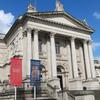More about Caligula’s Palace and Bridge

Sr. Contributor
Ever the lover of drama, Joseph Mallord William Turner does the infamous Roman emperor Caligula a fair amount of justice, even in the ruins of his once-grand palace.
When art historians call Turner a Romantic, they don’t mean that he knew to show up to a date with some chocolates and a bouquet of flowers. Romantic with a capital “R” refers to Romanticism, a movement that overtook nineteenth-century British art as a reaction to the dreadfully dull rationality of the Enlightenment. Turner’s brand of Romanticism is so recognizable that one of his early paintings, which deviates from his more developed style, was labeled a forgery for over a century.
For Turner, landscape painting was the ultimate art form. Like Frederic Edwin Church and the Hudson River School of artists, landscapes were just a medium for a larger message embedded within each painting. Turner’s painting recalls Caligula’s past glories and ultimate follies. Caligula, formally known as Gaius Julius Caesar Germanicus, was the fourth of the twelve Caesars of ancient Rome. Although Caligula only ruled for four years, he had a dramatic reign with a violent end. History remembers Caligula as a selfish and inept emperor whose lavish tastes and failures contributed to the Roman Empire’s downfall.
Turner features one of Caligula’s most questionable ventures. The lore surrounding Caligula describes a three-mile bridge that the emperor ordered to be built to connect the ancient Roman towns of Puteoli and Baiae. As an added flex, Caligula was said to have crossed his own bridge on horseback. According to legend, the bridge was constructed from boats that were fastened together. The bridge was largely considered pointless and, so, is a good example of Caligula’s frivolity. Turner used the infamous palace and bridge to illustrate the decay of past glories. Sadly, there is no evidence to prove the existence of the fabled, useless bridge, and modern historians have ultimately dismissed it as a myth. However, Caligula definitely lived a lavish life, complete with multiple pleasure barges that sailed Lake Nemi.
The drama doesn’t end with this work’s subject matter. Turner exhibited this painting in the 1831 Royal Academy, where it hung next to John Constable’s Salisbury Cathedral from the Meadows, one of the many companion pieces to his Salisbury Cathedral from the Bishop’s Garden. This happened to be the same year that Constable served on the exhibition’s Hanging Committee, which gave him privileged access to the exhibition. In a fit of spite, Constable replaced Turner’s painting with his own. However, Turner got the last laugh when he publicly teased Constable about this incident in front of other artists; much to Constable’s chagrin, everyone laughed along with Turner’s joke at Constable’s expense.
Sources
- Barker, Elizabeth E. “Joseph Mallord William Turner (1775-1851).” In Heilbrunn Timeline of Art History. New York: The Metropolitan Museum of Art. October 2004. https://www.metmuseum.org/toah/hd/trnr/hd_trnr.htm. Accessed 18 December 2021.
- Bolton, Will. “JMW Turner painting thought to be a fraud for over a century… is in fact a Turner.” 12 November 2021 for The Telegraph, https://www.msn.com/en-gb/travel/news/jmw-turner-painting-thought-to-be… (accessed 18 Dec 2021).
- Cohen, Jennie. “7 Things You May Not Know About Caligula.” History Stories. History. 30 August 2018. https://www.history.com/news/7-things-you-may-not-know-about-caligula. Accessed 18 December 2021.
- GTA Wiki. “Caligula’s Palace.” https://gta.fandom.com/wiki/Caligula%27s_Palace. Accessed 18 December 2021.
- Lidz, Franz. “Caligula’s Garden of Delights. Unearthed and Restored.” The New York Times. 12 January 2021. https://www.nytimes.com/2021/01/12/science/caligula-archaeology-rome-ho…. Accessed 18 December 2021.
- Tate. “Caligula’s Palace and Bridge.” Art & Artists. https://www.tate.org.uk/art/artworks/turner-caligulas-palace-and-bridge…. Accessed 18 December 2021.
- The Metropolitan Museum of Art. “Great Britain and Ireland, 1800-1900 A.D.” In Heilbrunn Timeline of Art History,.New York: The Metropolitan Museum of Art. October 2004. https://www.metmuseum.org/toah/ht/10/euwb.html. Accessed 18 December 2021.
Featured Content
Here is what Wikipedia says about Caligula's Palace and Bridge
Caligula's Palace and Bridge is an 1831 landscape painting by the British artist J.M.W. Turner. It is an imagined scene of the giant palace and bridge from Baiae to Puteoli across the Bay of Naples, built under the direction of the deranged Roman Emperor Caligula.
At the Royal Academy Exhibition of 1831 at Somerset House, this and another work by Turner Vision of Medea were hung either side of John Constable's Salisbury Cathedral from the Meadows providing a striking contrast which was picked up on by reviewers. This reportedly led to a row between the two men in front of their fellow artists, as Constable was on the hanging committee that chose were paintings would be placed.
Today the painting is in the collection of the Tate Britain in Pimlico, having been part of the Turner Bequest of 1856 Turner later engaged Edward Goodall to prodce an engraving based on the work.
Check out the full Wikipedia article about Caligula's Palace and Bridge












